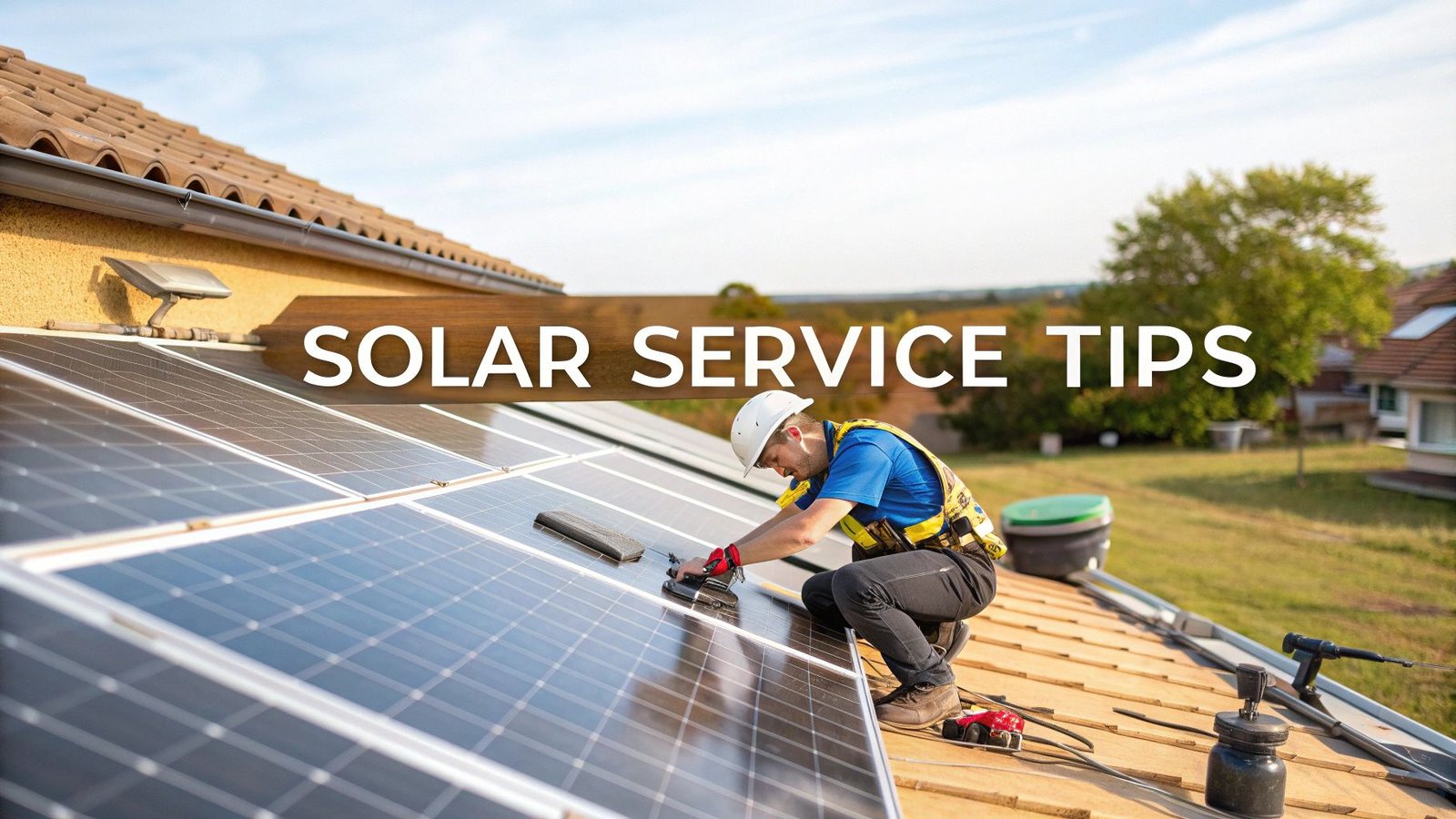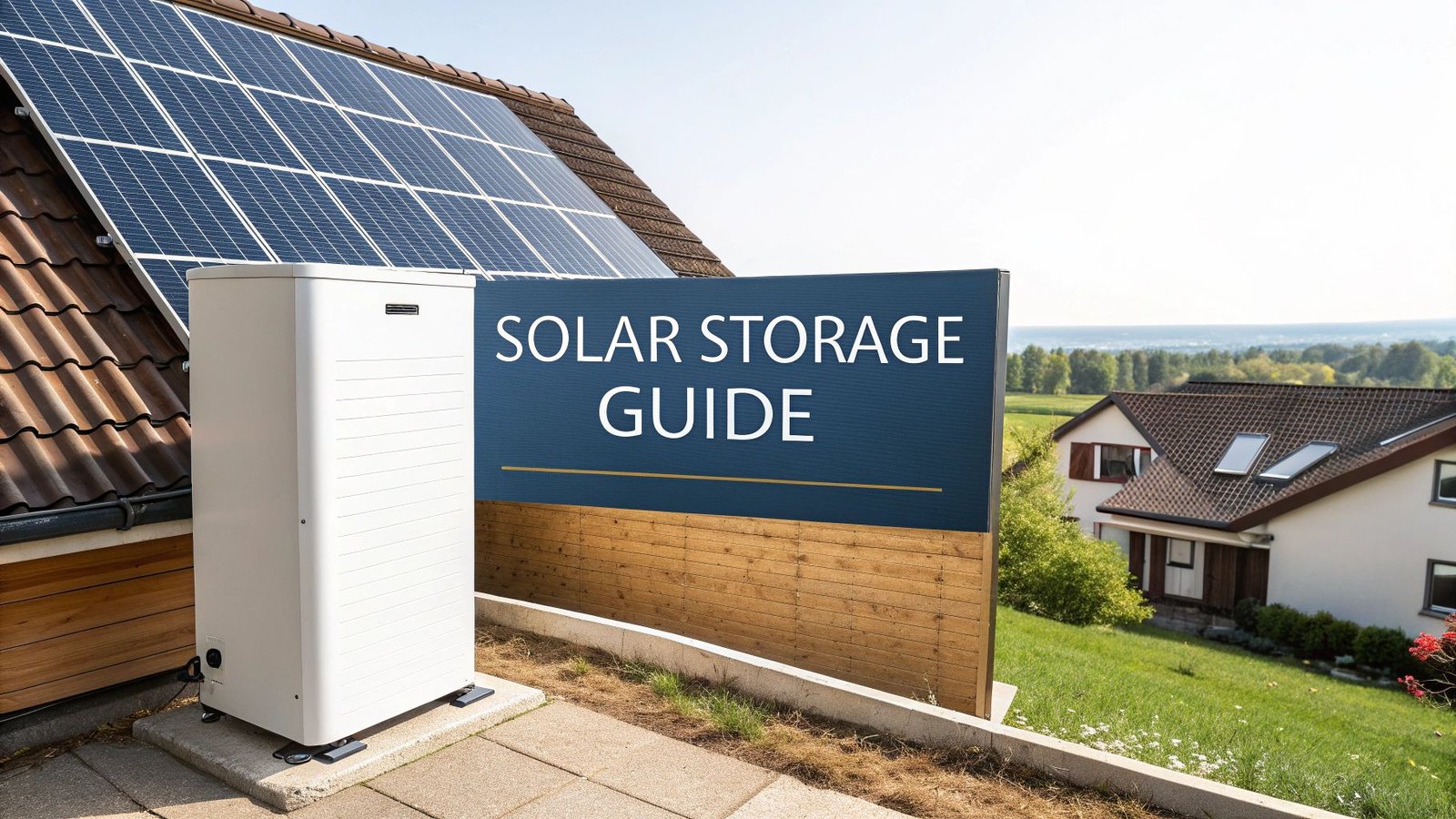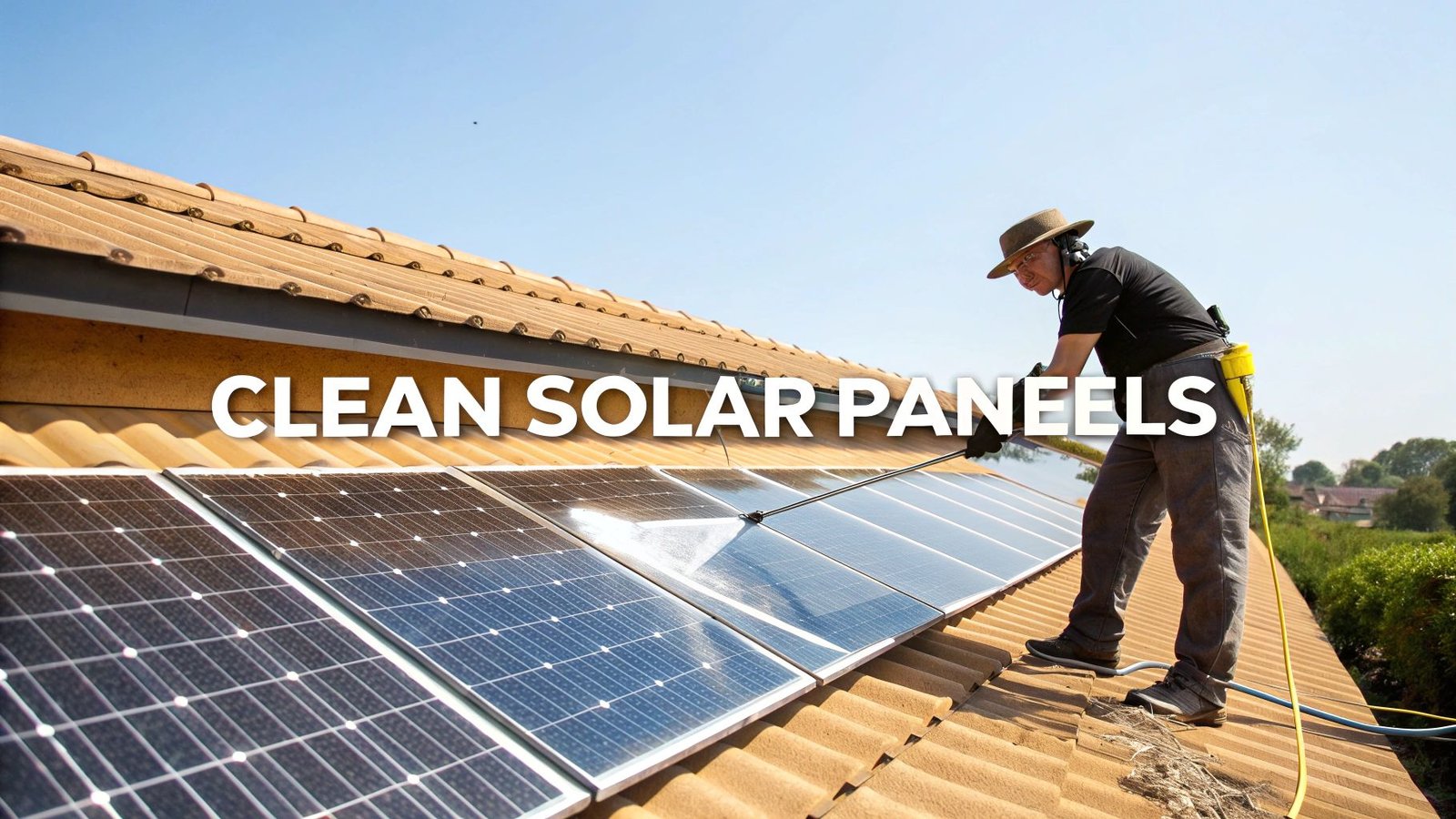You wouldn't buy a new car and then never change the oil, right? Your solar panel system is no different. Think of it as a high-performance engine sitting on your roof, and professional solar panel servicing is the regular tune-up it needs to keep running at its best.
This isn't just about protecting your investment; it's about making sure your system is safe, cranking out maximum power, and living a long, productive life. It’s the key difference between a system that simply functions and one that truly performs.
Why Servicing Is Your Solar System's Best Friend
It's easy to see servicing as just another expense, but it's smarter to view it as an investment. This is you taking a proactive step to protect the efficiency and health of your home's power plant.
Without these regular check-ups, you're almost certainly leaving money on the table. Small, unseen issues—a bit of grime, a loose connection—can quietly grow into big, expensive headaches if you ignore them.
A proper service is more than just a quick cleaning; it’s a full health screening for your entire setup. The benefits really stack up:
- Maximizing Your Energy Output: Clean panels grab more sunlight. More sunlight means more power, and that translates directly into lower electricity bills. It's that simple.
- Preventing Expensive Repairs: A trained technician can catch small problems, like the early signs of inverter failure or potential-induced degradation, before they turn into a major replacement bill.
- Keeping Your System Safe: Regular inspections confirm that all the wiring and electrical parts are secure and working as they should, which is crucial for preventing fire or electrical hazards.
- Extending Your System's Lifespan: Good maintenance helps your panels, inverter, and mounting gear last for their full intended lifespan—often 25 years or even longer.
Protecting Your Long-Term Investment
More and more homeowners are catching on. The solar panel maintenance market is growing at a steady clip, projected to expand by 8.6% annually through 2031. Why? Because people realize that without proper care, a system's performance can drop by 0.5% to 1% every single year. That slow decline really eats into your return on investment over the long haul.
This chart illustrates how even a small annual drop in efficiency can impact your system's output over its lifespan.
{
"type": "line",
"data": {
"labels": ["Year 1", "Year 5", "Year 10", "Year 15", "Year 20", "Year 25"],
"datasets": [
{
"label": "Optimal Performance",
"data": [100, 100, 100, 100, 100, 100],
"borderColor": "rgba(75, 192, 192, 1)",
"backgroundColor": "rgba(75, 192, 192, 0.2)",
"fill": false,
"tension": 0.1
},
{
"label": "Neglected System (1% Annual Loss)",
"data": [100, 96, 90, 86, 82, 78],
"borderColor": "rgba(255, 99, 132, 1)",
"backgroundColor": "rgba(255, 99, 132, 0.2)",
"fill": false,
"tension": 0.1
}
]
},
"options": {
"responsive": true,
"plugins": {
"legend": {
"position": "top"
},
"title": {
"display": true,
"text": "Impact of Neglect on Solar Panel Performance Over 25 Years"
}
},
"scales": {
"y": {
"title": {
"display": true,
"text": "Efficiency (%)"
}
}
}
}
}
This need for reliability isn't just for homeowners. It’s critical everywhere solar is used, from small-scale projects to incredible feats like an emission-free solar-powered voyage to Alaska, where peak performance is non-negotiable.
Regular servicing transforms your solar installation from a passive fixture on your roof into a high-performing asset that actively saves you money, year after year.
What a Comprehensive Solar Service Actually Includes

A lot of people assume solar panel servicing is little more than a fancy window washing. And while cleaning is definitely part of the job, a true professional service is much more—it’s a comprehensive, diagnostic health check for your entire solar energy system.
Think of it like this: wiping down your car's dashboard is one thing, but getting a full engine tune-up is another. One makes it look nice, but the other ensures it runs safely and efficiently for the long haul. That’s what a real solar service does.
It's More Than Just a Spray-Down
The most obvious part of any service is the panel inspection and cleaning. A good technician doesn't just show up with a hose. They're on the lookout for subtle signs of trouble that could blossom into major headaches down the road.
This means a careful inspection for things like:
- Microcracks and Hotspots: These are tiny, often invisible fractures in the solar cells that can worsen over time, seriously hurting your power output.
- Soiling and Debris: We're not just talking about dust. Stubborn bird droppings, sticky tree sap, or lichen can bake onto the glass and permanently damage the anti-reflective coating.
- Seal Integrity: Technicians check that the seals around the panel frames are solid. A compromised seal lets moisture in, leading to corrosion and internal damage.
A gentle but thorough cleaning follows, lifting away all the performance-killing grime so your panels can soak up every last ray of sun.
A professional solar service isn’t about making panels shiny; it’s a systematic inspection designed to identify and fix issues before they impact your energy production or safety.
To give you a clearer picture, here’s a breakdown of what a standard service visit typically covers, component by component.
Standard Solar Panel Servicing Checklist
| System Component | Service Task | Purpose of Task |
|---|---|---|
| Solar Panels | Visual inspection for cracks, hotspots, and damage. | To identify physical defects that reduce efficiency and could lead to system failure. |
| Solar Panels | Professional cleaning of panel surfaces. | To remove dirt, dust, and debris that block sunlight and reduce power generation. |
| Inverter | Check error logs and performance data. | To spot hidden electrical faults or signs of degradation before they cause a shutdown. |
| Inverter | Clean air vents and cooling fans. | To prevent overheating, which is a primary cause of inverter failure and power loss. |
| Mounting System | Inspect all racking bolts and clamps. | To ensure the entire array is securely fastened to the roof and can withstand severe weather. |
| Wiring & Conduits | Check for signs of corrosion, UV damage, or pest-related issues. | To maintain electrical safety, prevent power loss, and avoid potential fire hazards. |
This checklist shows how a service goes far beyond a simple wash, touching every critical part of your solar investment.
Checking the Brains of the Operation
Next up is the inverter—the hardworking core of your system. This crucial device is what turns the DC electricity from your panels into the AC electricity your home actually uses. If the inverter fails, your entire system goes dark.
During a service, a technician will:
- Look for signs of overheating. They'll inspect vents and cooling fans for dust buildup, because heat is the number one enemy of inverters. A clean filter can be the difference between a working system and a premature, costly replacement.
- Verify all electrical connections. Loose or corroded connections are a major source of power loss and can even become a fire hazard. Everything needs to be tight and clean.
- Review performance data. Technicians dig into the inverter's error logs and production history to spot any strange patterns that might signal a looming problem.
Securing the Foundation
Finally, a complete service involves a full inspection of the mounting hardware and wiring. This is the skeleton of your system, holding the panels to your roof and safely channeling the power into your home.
A technician will meticulously check the racking for any loose bolts or corrosion, making sure it's ready to handle high winds and whatever else the weather throws at it. They also inspect all visible wiring and conduits for damage from sun exposure or pesky critters, which could otherwise compromise the system’s safety.
For a more granular look at what's involved, our solar panel maintenance checklist provides a great breakdown. This all-encompassing approach ensures every single part of your system is working in harmony for peak performance.
Why Regular Solar Maintenance Makes Financial Sense
It’s easy to think of solar panel servicing as just another recurring bill. But that’s missing the forest for the trees. The reality is, it's an investment that actively protects the money-saving power of your system. Without it, your panels are silently losing their punch, and that costs you real money year after year.
This slow decline in efficiency isn't just a "what if" scenario; it's a certainty. Everyday things are working against your system's output. For example, soiling loss—a simple buildup of dust, pollen, and grime—can seriously block the sunlight your panels need to absorb.
Then there are the less obvious culprits. Potential-induced degradation (PID) is a technical issue that can quietly drain your system's power over time. Regular check-ups are designed to catch these problems early, before they snowball into major financial hits.
The Long-Term Financial Picture
Let’s put this into perspective. Think about the small, predictable cost of an annual service visit versus the slow, compounding financial leak from a neglected system. That yearly maintenance fee might feel like an extra expense now, but it's a drop in the bucket compared to the savings you lose from unchecked performance issues.
The image below shows some of the common culprits a technician looks for, like tiny micro-cracks or that pesky layer of dust that directly cuts into your energy production.

These are exactly the kinds of "small" problems that a professional service is designed to find and fix, ensuring your investment keeps paying you back for the long haul.
How Degradation Hits Your Wallet
Let's run some numbers on a standard 5kW system. If you let neglect cause even a 1% drop in performance each year, you’re generating less and less free electricity. Over the 25-year life of your panels, those small annual losses add up to a significant chunk of money you're leaving on the table.
Think of professional servicing less as an expense and more as a financial strategy. It’s about making sure you get every last dollar of value out of your solar investment.
Regular maintenance is your best defense against these losses. A good cleaning, for example, directly combats soiling, which can drag down your output by anywhere from 5% to 20%, depending on your local environment. The math is pretty clear—servicing pays for itself.
{
"type": "bar",
"data": {
"labels": ["Clean Panel", "Light Soiling", "Heavy Soiling"],
"datasets": [{
"label": "Energy Output (%)",
"data": [100, 95, 80],
"backgroundColor": [
"rgba(75, 192, 192, 0.6)",
"rgba(255, 206, 86, 0.6)",
"rgba(255, 99, 132, 0.6)"
],
"borderColor": [
"rgba(75, 192, 192, 1)",
"rgba(255, 206, 86, 1)",
"rgba(255, 99, 132, 1)"
],
"borderWidth": 1
}]
},
"options": {
"responsive": true,
"plugins": {
"legend": {
"display": false
},
"title": {
"display": true,
"text": "Impact of Soiling on Solar Panel Output"
}
},
"scales": {
"y": {
"beginAtZero": true,
"max": 100,
"title": {
"display": true,
"text": "Efficiency Percentage"
}
}
}
}
}
Of course, you can't fix a problem you don't know you have. This is where a good solar monitoring system becomes your best friend. It lets you keep a constant eye on your production data, so you’ll know the moment things start to dip. Combine that data with routine professional check-ups, and you've built a powerful defense against performance loss, ensuring your panels deliver the savings you signed up for.
DIY Servicing Versus Hiring a Professional
When it comes to looking after your solar panels, one of the first questions you'll ask is: should I do this myself or call a pro? The truth is, it’s not always an either-or decision. The best strategy is usually a mix of both. Some jobs are perfectly fine for a handy homeowner, while others carry serious risks and are best left to the experts.
So, how do you decide? It really comes down to a few key things: your comfort level with home maintenance, the tools you have on hand, and most importantly, safety. While the idea of saving a few bucks with a DIY approach is always appealing, you have to weigh that against the real risks of damaging your system or, even worse, getting hurt.
What You Can Safely Do Yourself
If you're comfortable with basic upkeep, a few simple tasks can help keep your system running smoothly between professional check-ups. These jobs are low-risk and don't require you to mess with any wiring.
The most common DIY job is cleaning. For panels you can easily and safely reach from the ground, a light spray with a garden hose is often enough to wash away dust and pollen. If they need a bit more attention, it’s worth learning how to clean solar panels properly to avoid accidentally scratching the glass.
Other safe DIY checks include:
- Visual Inspections: Take a walk around and look up at your panels from the ground. See any leaves, branches, or bird droppings? Anything that casts a shadow is costing you energy.
- Monitoring System Output: Keep an eye on your system’s monitoring app. If you notice a sudden, unexplained drop in energy production, that’s your cue to call in an expert.
When to Absolutely Call a Professional
Now for the important part. Some tasks are strictly for certified solar technicians. Trying to handle these yourself isn't just dangerous—it could easily void your system's warranty.
Here’s a simple rule to live by: if the job requires getting on the roof or touching any electrical components, it’s time to call a professional. The risk of a fall or a serious electrical shock is just too high to gamble with.
Professionals have the training, tools, and safety gear to handle the tricky parts of solar maintenance. They're the ones you need for:
- Electrical Testing: Technicians use specialized meters to check that all the wiring, connections, and voltage levels are safe and operating correctly.
- Inverter Diagnostics: The inverter is the brain of your solar setup. A pro can run diagnostics, troubleshoot error codes, and perform software updates to keep it healthy.
- Rooftop Work: This is non-negotiable. Professionals use safety harnesses and have the experience to work on a roof without hurting themselves or damaging your home.
- Identifying Microcracks: Experts can spot tiny signs of damage, like hairline cracks or hotspots, that you’d never see from the ground. Catching these early can save a panel’s life.
To make the choice clearer, let's break down the pros and cons side-by-side.
Comparing DIY vs Professional Solar Servicing
| Factor | DIY Servicing | Professional Servicing |
|---|---|---|
| Safety | High risk for any electrical or rooftop work. Limited to ground-level tasks only. | Low risk for the homeowner. Technicians are trained and insured. |
| Cost | Lower upfront cost. Only involves the price of basic cleaning supplies. | Higher upfront cost. You're paying for expertise, labor, and safety. |
| Scope | Very limited. Primarily visual checks and basic cleaning. | Comprehensive. Includes electrical diagnostics, inverter health, and detailed inspections. |
| Effectiveness | Good for routine upkeep. Helps maintain performance between professional visits. | Essential for long-term health. Identifies and fixes complex issues before they become major problems. |
Ultimately, a combined approach is a winning formula. Handle the simple, safe tasks yourself to keep things tidy, but always bring in a qualified professional for the annual or biannual deep-dive inspection. This ensures your system stays safe, efficient, and protected for years to come.
How to Choose a Reliable Solar Servicing Company

Deciding to bring in a professional for solar panel servicing is a solid call. Now comes the real work: finding a company you can trust to handle the job properly. As the solar maintenance market booms, it’s more important than ever to sort the qualified pros from the low-cost amateurs.
It's a huge industry, with the global solar operation and maintenance market hitting an estimated $5.83 billion in 2024. That growth means you have more choices, but it also means you have to be more discerning. You can get a better sense of this expanding market by checking out the analysis on ResearchAndMarkets.com. Your mission is to find a partner who will give your system the expert attention it needs.
Non-Negotiable Qualifications
Before you even glance at a price tag, there are a few must-haves. Think of these as the bare minimum for letting someone get up on your roof and work on your valuable energy system.
-
Proper Licensing and Insurance: This is non-negotiable. The company must be licensed for electrical work in your state and carry full liability insurance. This protects you in the unlikely event something goes wrong—from a cracked panel to an accident on your property.
-
NABCEP Certification: The North American Board of Certified Energy Practitioners (NABCEP) is the gold standard in the solar world. When you see a company employs NABCEP-certified technicians, it’s a clear sign they’re serious about quality, safety, and staying up-to-date.
-
Positive Reviews and References: What are other homeowners saying? Check for a solid track record on sites like Google, Yelp, or even the Better Business Bureau. And don't be shy about asking for a few references you can call yourself.
Choosing a certified and insured professional isn't just about checking a box; it's about peace of mind. You're entrusting a critical home asset to their care, so their credentials matter immensely.
Key Questions to Ask Potential Providers
Once a company clears the initial hurdles, it’s time to dig a little deeper. The way they answer the following questions will tell you a lot about their process, transparency, and the quality you can expect. A true pro will be happy to answer them.
Start by asking exactly what’s included in their standard service package. Don't settle for a vague answer; ask for a detailed checklist. You want to see more than just a quick wipe-down of the glass—a thorough service should include inverter diagnostics, a wiring inspection, and a check of all mounting hardware.
Also, ask if they provide a detailed report after the service is complete. The best ones will give you a full write-up, often with photos, showing you what they found and what they did. This document is proof of work and a valuable health record for your system.
Finally, ask about their direct experience with your specific brand of panels and inverter. Some equipment has its own quirks, and you want someone who knows what they’re looking at. Be wary of anyone using high-pressure sales tactics or offering a price that sounds too good to be true—it usually is.
Got Questions About Solar Panel Servicing? We've Got Answers.
Even with a good grasp of the benefits, it's natural to have a few practical questions about what solar panel servicing really involves. Let's tackle some of the most common ones I hear from homeowners, so you can feel confident about taking care of your system.
How Often Should I Really Get My Solar Panels Serviced?
For most homes, getting a professional to look over your system every 1 to 2 years is the sweet spot. It's frequent enough to catch any small issues before they become big problems, but not so often that you're spending money unnecessarily.
Of course, your local environment is a huge factor. If you live somewhere with a lot of dust, nearby farms, heavy pollution, or salty coastal air, you'll want to lean towards an annual service. That gunk builds up fast and can really drag down your production. On the flip side, if you're in a cleaner area with less airborne debris, stretching it to every two years is usually perfectly fine.
Here's a simple rule of thumb: Think about how quickly your car gets dirty just sitting in the driveway. If it's covered in a layer of dust or pollen in no time, your panels are too. An annual check-up is your safest bet for keeping them at peak performance.
I also tell my clients to do their own quick visual checks from the ground once a season. Just a quick scan for obvious stuff like a buildup of leaves, a rogue branch, or a bunch of bird droppings can help you spot potential slowdowns early.
What's a Realistic Cost for Solar Panel Servicing?
You can generally expect a standard service for a residential system to run between $150 and $400. What you'll actually pay depends on a few key things.
The final price tag is influenced by:
- How many panels you have on your roof.
- How easy it is to get to them (a steep, two-story roof costs more than a low-pitch, single-story one).
- What's included in the service package you choose.
A basic cleaning, for instance, will be on the lower end of that range. But if you opt for a more thorough check-up that includes detailed electrical testing, inverter diagnostics, and a full system health report, you'll be looking at the higher end. Always ask for an itemized quote so you know exactly what you're paying for.
Could I Accidentally Void My Warranty by Skipping Service?
It's not likely that simply skipping a service will outright void your manufacturer's warranty, but it can definitely create problems if you need to file a claim. Think of it this way: warranties cover defects in the equipment itself, not issues that come up because the system wasn't properly cared for.
For example, say your inverter overheats and fails. If the technician discovers its cooling vents are completely clogged with dust and leaves, the manufacturer could argue that the failure was due to neglect, not a product defect. In that case, your claim could be denied.
Having a record of regular solar panel servicing from a professional is your best defense. That paper trail proves you've held up your end of the bargain, which can make a huge difference if you ever run into a warranty issue.
Can I Just Use Dish Soap to Clean My Panels?
Please don't! You should never use regular household soaps, detergents, or anything abrasive on your solar panels. These products often do more harm than good. Many soaps leave behind a thin, sticky film that actually becomes a magnet for more dirt, meaning your panels get grimy again even faster.
Even worse, harsh chemicals or a scrubby sponge can easily scratch the anti-reflective coating on the glass. That damage is permanent and will hobble your panels' ability to produce power for the rest of their lives.
The pros use de-ionized water and special, soft-bristle brushes made for the job. If a cleaning agent is needed, it will always be a solution specifically formulated for solar panels. Your best bet is to stick to what the professionals use or, at the very least, follow your panel manufacturer's cleaning guide to the letter.
At Radiant Energy, we see proper maintenance as the key to unlocking every last watt of power your solar system can produce. Our certified pros provide expert solar panel servicing to ensure your system runs safely and at peak efficiency for decades. Protect your investment and maximize your savings—schedule a comprehensive system check-up with us today.




